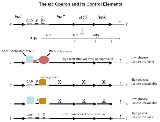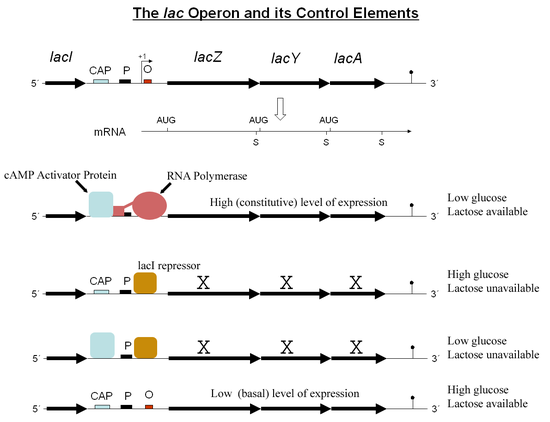
Catabolite Activator Protein
Encyclopedia

Ligand (biochemistry)
In biochemistry and pharmacology, a ligand is a substance that forms a complex with a biomolecule to serve a biological purpose. In a narrower sense, it is a signal triggering molecule, binding to a site on a target protein.The binding occurs by intermolecular forces, such as ionic bonds, hydrogen...
-binding domain at the N-terminus (CAPN, residues 1-138), which is also responsible for the dimerization of the protein, and a DNA-binding domain
DNA-binding domain
A DNA-binding domain is an independently folded protein domain that contains at least one motif that recognizes double- or single-stranded DNA. A DBD can recognize a specific DNA sequence or have a general affinity to DNA...
at the C-terminus (DBD, residues 139-209). Two cAMP (cyclic AMP) molecules bind dimeric CAP with negative cooperativity
Cooperativity
Cooperativity is a phenomenon displayed by enzymes or receptors that have multiple binding sites where the affinity of the binding sites for a ligand is increased, positive cooperativity, or decreased, negative cooperativity, upon the binding of a ligand to a binding site...
and function as allosteric effectors by increasing the protein's affinity for DNA
DNA
Deoxyribonucleic acid is a nucleic acid that contains the genetic instructions used in the development and functioning of all known living organisms . The DNA segments that carry this genetic information are called genes, but other DNA sequences have structural purposes, or are involved in...
. Cytosol
Cytosol
The cytosol or intracellular fluid is the liquid found inside cells, that is separated into compartments by membranes. For example, the mitochondrial matrix separates the mitochondrion into compartments....
ic cAMP levels rise when the amount of glucose
Glucose
Glucose is a simple sugar and an important carbohydrate in biology. Cells use it as the primary source of energy and a metabolic intermediate...
transported into the cell is low, but lactose
Lactose
Lactose is a disaccharide sugar that is found most notably in milk and is formed from galactose and glucose. Lactose makes up around 2~8% of milk , although the amount varies among species and individuals. It is extracted from sweet or sour whey. The name comes from or , the Latin word for milk,...
is readily available.
CAP has a characteristic helix-turn-helix
Helix-turn-helix
In proteins, the helix-turn-helix is a major structural motif capable of binding DNA. It is composed of two α helices joined by a short strand of amino acids and is found in many proteins that regulate gene expression...
structure which allows it to bind to successive major grooves on DNA. The two helices are reinforcing each causing a 43° turn in the structure so overall causing a 94° degree turn in the DNA.
This opens the DNA molecule up, allowing RNA polymerase
RNA polymerase
RNA polymerase is an enzyme that produces RNA. In cells, RNAP is needed for constructing RNA chains from DNA genes as templates, a process called transcription. RNA polymerase enzymes are essential to life and are found in all organisms and many viruses...
to bind and transcribe
Transcription (genetics)
Transcription is the process of creating a complementary RNA copy of a sequence of DNA. Both RNA and DNA are nucleic acids, which use base pairs of nucleotides as a complementary language that can be converted back and forth from DNA to RNA by the action of the correct enzymes...
the genes involved in lactose catabolism
Catabolism
Catabolism is the set of metabolic pathways that break down molecules into smaller units and release energy. In catabolism, large molecules such as polysaccharides, lipids, nucleic acids and proteins are broken down into smaller units such as monosaccharides, fatty acids, nucleotides, and amino...
. CAP thus enhances the expression of the lac operon
Lac operon
The lac operon is an operon required for the transport and metabolism of lactose in Escherichia coli and some other enteric bacteria. It consists of three adjacent structural genes, lacZ, lacY and lacA. The lac operon is regulated by several factors including the availability of glucose and of...
when lactose is present but not glucose.
This requirement reflects the greater simplicity with which glucose may be metabolized in comparison to lactose. The cell "prefers" glucose, and if it is available, the lac operon is not activated, even when lactose is present. This is an effective way of integrating the two different signals.
CAP is responsible for catabolite repression
Catabolite repression
Carbon catabolite repression, or simply catabolite repression, is an important part of global control system of various bacteria and other micro-organisms. Catabolite repression allows bacteria to adapt quickly to a preferred carbon and energy source first...
, a well known example of a modulon
Modulon
An operon is a set of genes controlled by a single DNA binding protein. Multiple operons controlled by the same repressor are grouped together as a regulon....
.

